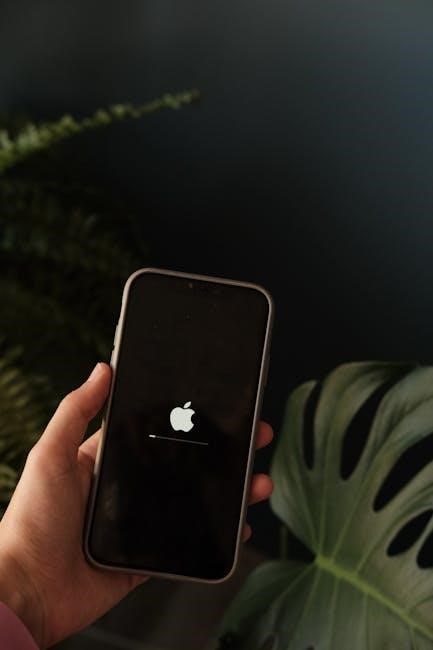
manual sync module firmware update required blink
The Blink Sync Module is a central hub connecting your security cameras, ensuring seamless communication and functionality. Firmware updates are crucial for maintaining security, fixing bugs, and enhancing performance. Regular updates ensure your system remains efficient and protected against vulnerabilities. Ignoring updates can lead to connectivity issues or compromised security. This guide will walk you through the process of manually updating your Sync Module firmware, troubleshooting common issues, and best practices for maintaining optimal device performance.
What is a Blink Sync Module?
The Blink Sync Module acts as the central communication hub for your Blink security cameras, connecting them to the Blink app and ensuring seamless functionality. It enables camera operation, video streaming, and motion detection features. The module communicates with cameras wirelessly and manages firmware updates, ensuring devices stay secure and perform optimally. Without the Sync Module, cameras cannot connect to the Blink ecosystem, highlighting its essential role in your home security system. It is a critical component for maintaining connectivity and enabling advanced features, making it indispensable for a smooth user experience. Proper functioning of the Sync Module is vital for reliable camera performance.
Why Firmware Updates are Essential
Firmware updates are crucial for maintaining the security, functionality, and performance of your Blink Sync Module. They patch vulnerabilities, fix bugs, and improve system stability. Updates often introduce new features, enhance compatibility with cameras, and ensure optimal performance. Ignoring updates can leave your system exposed to security risks or malfunctioning. Regular updates ensure your module stays aligned with the latest technology and maintains seamless communication with your Blink cameras. By keeping your firmware up-to-date, you safeguard your home security system and ensure uninterrupted monitoring. Updates are vital for protecting your investment and maintaining a reliable, efficient, and secure home security setup.

Understanding the “Manual Sync Module Firmware Update Required” Message
This message signals that your Blink Sync Module requires manual intervention to update its firmware, ensuring security and efficiency. It indicates outdated firmware may cause server rejection.
Causes of the Update Notification
The “Manual Sync Module Firmware Update Required” notification typically appears due to outdated firmware, connectivity issues, or security patches. It may also indicate new feature updates or compatibility improvements. Additionally, server-side changes or rejection of outdated firmware by Blink servers can trigger this alert. Ensuring your module is updated is crucial for maintaining functionality and security.
Consequences of Ignoring the Update
Ignoring the “Manual Sync Module Firmware Update Required” notification can lead to security vulnerabilities, loss of new features, and unstable performance. Outdated firmware may cause connectivity issues, camera malfunctions, or exposure to potential breaches. Over time, compatibility with newer devices or software may degrade, disrupting your security system. Neglecting updates can also result in the module becoming non-functional or “bricked,” requiring a factory reset or replacement. Regular updates are essential to ensure your Blink system remains secure, efficient, and fully operational. Prolonged neglect can compromise your home’s security and leave your system vulnerable to exploitation.

Preparation for a Manual Firmware Update
Ensure stable internet connectivity, download the latest firmware from official sources, and back up your current settings before proceeding with the update process.
Checking Internet Connectivity
A stable internet connection is crucial for a successful manual firmware update. Ensure your Blink Sync Module is connected to a reliable network. Weak or unstable connections can cause the update to fail, potentially requiring a factory reset. To verify connectivity, check the LED indicators on your Sync Module. A solid blue light indicates a stable connection, while a blinking blue light suggests it is attempting to connect. If connectivity issues persist, power cycle your router or restart the Sync Module. A failed update due to poor connectivity may result in device malfunction, requiring further troubleshooting or professional assistance.
Downloading the Latest Firmware
To ensure a successful manual firmware update, always download the latest firmware from the official Blink app or website. Open the Blink app, navigate to the Sync Module section, and check for available updates. The app will guide you through the download process. Avoid using third-party sources, as they may pose security risks or provide outdated versions. Once downloaded, the app will verify the firmware’s integrity to ensure it is safe and compatible. A stable internet connection is essential during this step to prevent interruptions. Follow the on-screen instructions carefully to complete the download process successfully.
Backing Up Settings
Before initiating a manual firmware update, it is crucial to back up your current settings to avoid losing custom configurations. The Blink Sync Module stores settings like camera configurations, notification preferences, and network details. To back up, go to the Blink app settings and look for an option to export or save your current configurations. Some settings may need to be manually noted, such as Wi-Fi passwords or camera names. After the update, you can restore these settings to maintain your system’s functionality. This step ensures a smooth transition and prevents the need to reconfigure your system from scratch.

Step-by-Step Manual Sync Module Firmware Update Process
Access the Blink app, select your Sync Module, and navigate to its settings. Choose the firmware update option, then follow in-app instructions to complete the process successfully.
Accessing the Blink App
To begin the manual firmware update process, open the Blink app on your smartphone or tablet. Ensure your device has a stable internet connection. Tap on the Sync Module section from the app’s homepage. If an update is required, a notification will appear. Select the module you wish to update and follow the in-app prompts. Make sure you are logged into your Blink account and have administrative privileges. The app will guide you through the update process, ensuring a smooth transition to the latest firmware version. Always use the official Blink app for updates to avoid compatibility issues.
Selecting the Sync Module
After opening the Blink app, navigate to the Devices tab. Locate and select the Sync Module requiring the firmware update. Ensure the module is listed as online to proceed. If multiple modules are connected, choose the specific one needing attention. The app will display details such as the module’s current firmware version and update availability. Confirm your selection by tapping on the module’s name or associated update icon. This step ensures the update is applied to the correct device, preventing any potential conflicts with other connected modules in your system.
Initiating the Firmware Update
Once the Blink Sync Module is selected, navigate to the Firmware Update option within the app. Click on the Update Now button to begin the process. The app will prompt a confirmation message to ensure you intend to proceed. After confirmation, the update will start automatically. The Blink app will handle the download and installation of the latest firmware version. Ensure the module remains powered on and connected to the internet throughout the process. Avoid interrupting the update, as this could cause system instability or require a full reset. The app will notify you once the update is successfully completed.
Monitoring the Update Progress
During the firmware update, the Blink app will display a progress bar indicating the update’s status. The Sync Module’s LED lights will also change to reflect the process: a blinking blue light typically signifies the update is in progress. Avoid unplugging the module or closing the app, as this could disrupt the update. The process usually takes a few minutes, depending on the update size. Once complete, the LED will return to its normal state, and the app will confirm the update was successful. If the progress appears stuck, restart the module and retry the update process. Always wait for confirmation before proceeding.

Troubleshooting Common Issues During Update
Common issues during updates include connectivity problems, failed updates, or devices not responding. Check your internet connection, power cycle the module, and restart the update process if interrupted. Ensure the app is up-to-date and avoid closing it during the update. If issues persist, reset the module or reinstall the app. Always follow official guidelines for troubleshooting steps to prevent further complications. Regular maintenance and checking for additional updates can help resolve recurring issues effectively.
Resolving Connectivity Problems
To resolve connectivity issues during a manual firmware update, ensure your Blink Sync Module is connected to a stable internet network. Power cycle the module by unplugging it for 10 seconds, then plug it back in. Check that your router is functioning properly and that your device has a strong connection. Verify that the Blink app is up-to-date, as an outdated app may cause communication problems. If issues persist, restart your router or contact Blink support for further assistance. Ensuring a stable connection is crucial for successful firmware updates and maintaining optimal device performance and security.
Handling Failed Updates
If a firmware update fails, restart the Blink Sync Module by unplugging it for 10 seconds and plugging it back in. Ensure a stable internet connection and retry the update. If the issue persists, use a paper clip to press and hold the reset button while reconnecting power—this can resolve corruption issues. After resetting, re-add the Sync Module in the Blink app and attempt the update again. If problems continue, contact Blink support for assistance. Failed updates may require re-initializing the device or checking for specific Wi-Fi password requirements, such as including an uppercase letter. Persistent issues may need professional help.

Recovering from a Bricked Device
If your Sync Module becomes unresponsive after a failed update, it may be “bricked.” Start by performing a hard reset: unplug the device, press and hold the reset button with a paper clip, and plug it back in while holding the button. Release after 10 seconds. This process restores factory settings. Re-add the Sync Module in the Blink app and attempt the firmware update again. If the device remains non-functional, contact Blink support for potential replacement options. Ensure all steps are followed carefully to avoid permanent damage. Recovery may require advanced troubleshooting or professional assistance if the issue persists.

Preventing Future Firmware Update Issues
- Enable automatic firmware updates in the Blink app to ensure your Sync Module stays up-to-date without manual intervention.
- Regularly check for updates and maintain a stable internet connection to prevent interrupted or failed updates.
Automating Firmware Updates
Enabling automatic firmware updates for your Blink Sync Module ensures that your device stays up-to-date with the latest security patches and feature enhancements without manual intervention. To activate this feature, navigate to the settings section in the Blink app and select the option for automatic updates. This allows the system to download and install updates in the background, providing a seamless experience. Regular automated updates reduce the risk of missing critical updates and keep your system secure and efficient. Ensure a stable internet connection for uninterrupted updates and rely on the app to handle the process effortlessly.
Regular Maintenance Checks
Regular maintenance checks are essential to ensure your Blink Sync Module operates smoothly. Start by verifying the module’s physical connections, ensuring all cables are securely plugged in. Next, check the LED indicators to confirm the device is online and functioning correctly. Periodically review system logs in the Blink app for any error messages or warnings. Additionally, power cycle the module every few months by unplugging it for 10 seconds to reset internal components. These simple steps help prevent issues before they arise, ensuring your security system remains reliable and secure. Consistent upkeep also complements automated updates for optimal performance.

Best Practices for Blink Sync Module Management
Adhere to best practices to maintain your Blink Sync Module’s performance. Always use official update channels and ensure stable internet connectivity during firmware updates. Regularly power cycle the module to prevent software glitches. Avoid unofficial modifications and keep your device in a well-ventilated area to prevent overheating. By following these guidelines, you ensure smooth operation, security, and longevity of your Blink system. Consistent upkeep and adherence to official recommendations are key to a reliable home security setup.
Power Cycling the Module
Power cycling your Blink Sync Module is a simple yet effective troubleshooting step. To do this, unplug the power cord from the module, wait 10 seconds, and plug it back in. This process resets the device, clearing temporary glitches and restoring connectivity. Regular power cycling can prevent software-related issues and ensure smooth operation. It’s often recommended before performing firmware updates or when experiencing persistent connectivity problems. Always power cycle the module as a first step in troubleshooting to resolve minor issues quickly and efficiently. This practice helps maintain optimal performance and ensures your security system remains reliable and responsive.
Using Official Update Channels
When performing a Manual Sync Module Firmware Update, it’s crucial to use only official update channels provided by Blink. Downloading firmware from unauthorized sources can lead to security vulnerabilities or device malfunctions. Always verify the source of the update to ensure it’s legitimate. Blink’s official updates are thoroughly tested for compatibility and security, reducing the risk of errors during the update process. Avoid third-party software or unofficial websites, as they may provide outdated or corrupted files. Stick to the Blink app or official website for updates to maintain your device’s integrity and functionality. This ensures a smooth and secure update experience.

Frequently Asked Questions
Can I Use Blink Cameras Without a Sync Module? Yes, Blink cameras can function without a Sync Module, but connectivity and features may be limited.
How Do I Reset My Sync Module? Reset by unplugging, pressing the reset button with a pin, and replugging.
What Do the LED Indicators Mean? LEDs signal status: solid blue for operation, blinking green for connectivity issues, and red for errors.
Can I Use Blink Cameras Without a Sync Module?
Blink cameras can operate without a Sync Module, but functionality is limited. The Sync Module enhances features like local storage, battery management, and seamless connectivity. Without it, cameras rely solely on direct internet connections, which may reduce performance and integration capabilities. For optimal use, the Sync Module is recommended to ensure all features work as intended. If you choose to use cameras without it, ensure stable internet and update firmware regularly for security and efficiency.
How Do I Reset My Sync Module?
To reset your Blink Sync Module, unplug it from the power source. Use a paper clip to press and hold the reset button while plugging it back in. Hold for 30 seconds. This restores factory settings, erasing custom configurations. Alternatively, power cycle by unplugging for 10 seconds. After resetting, ensure the module is updated via the Blink app. Resetting is useful for resolving connectivity issues or preparing for a firmware update. Always back up settings before resetting to avoid losing custom configurations. This process ensures your Sync Module operates smoothly and remains secure. Regular resets can help maintain optimal performance and connectivity.
What Do the LED Indicators Mean?

The LED indicators on the Blink Sync Module provide crucial information about its status. A steady blue light indicates the module is powered on and operational. A blinking blue light suggests it is attempting to connect or is in a process like a firmware update. A steady green light signifies a successful internet connection, while a blinking green light may indicate data transfer or synchronization with cameras. A red light, if present, typically signals an error or problem, such as a connectivity issue or failed update. Yellow might indicate a warning, like a pending update or low battery. Specific patterns, such as blue and green lights blinking together, may denote modes like setup or pairing. These indicators help users quickly assess the module’s state, aiding in troubleshooting and maintaining system functionality. Understanding these signals enables effective management of your security system.
Keeping your Blink Sync Module firmware updated is crucial for optimal performance and security. Regular updates ensure your system runs smoothly and stays protected.
Importance of Keeping Firmware Updated
Keeping your Blink Sync Module firmware updated is essential for ensuring optimal performance, security, and reliability. Firmware updates often include critical security patches, new features, and bug fixes that enhance your device’s functionality. Outdated firmware can leave your system vulnerable to potential breaches and may cause connectivity issues with your Blink cameras. Regular updates ensure that your Sync Module operates smoothly and remains compatible with the latest camera models and software advancements. Ignoring updates can lead to compromised security and reduced efficiency, making it crucial to prioritize firmware maintenance for a secure and seamless home security experience.
Final Tips for Smooth Operation
To ensure your Blink Sync Module operates smoothly, always keep your firmware updated and maintain a stable internet connection. Regularly power cycle your module to clear temporary glitches and check for updates in the Blink app. Avoid using unofficial update channels to prevent potential issues. If you encounter problems, reset your module by unplugging it, waiting 10 seconds, and plugging it back in. For persistent issues, contact Blink support for assistance. By following these tips, you can maintain a secure, efficient, and reliable home security system. Consistent maintenance ensures your cameras stay connected and your home remains protected.